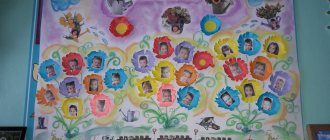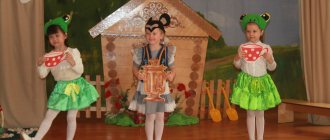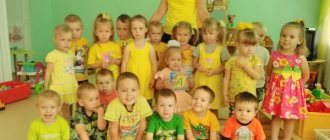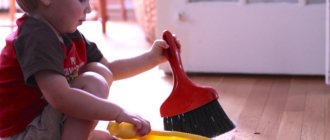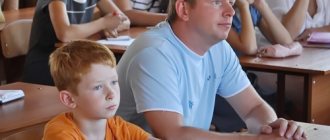Training to unite teachers in kindergarten I+YOU=WE
Training to unite teachers in kindergarten I+YOU=WE
Recently, various teambuilding tasks have become fashionable - team building. Such trainings are especially relevant in kindergarten, where all teachers must act harmoniously. The price of the issue is the adaptation of children to a preschool institution.
The training was developed by Lyudmila Aleksandrovna Unalova, teacher-psychologist of the preschool educational institution “Academy”, Astana Kazakhstan
Purpose of the training:
- team building and building effective team interaction.
Training objectives:
- formation and strengthening of a common team spirit by uniting a group of people;
- development of responsibility and contribution of each participant to solving common problems;
- awareness of oneself as a team.
Progress of the training:
Stage 1. Getting to know each other
— Hello, dear colleagues, today you and I will take part in a training called “I + YOU = WE.” The purpose of the training is to unite the team and build effective team interaction. In a circle, have everyone continue the sentence “Now I feel...”.
— Every training has rules. Let us also develop our own rules...
- Here and now (during the training we only talk about what worries everyone right now, and discuss what is happening to us right here).
- I speak for myself.
- Listen carefully to each other.
- Don't interrupt the speaker.
- Respect each other's opinions.
- Non-judgmental judgments.
- Activity.
- Stop rule.
- Confidentiality (everything that happens here is not shared outside the group under any pretext).
Each point of the rules is explained by the presenter.
MY NAME IS... I DO THIS....
Purpose: acquaintance, relief of anxiety, promotes memorization of names.
The exercise can be done sitting or standing. Each participant in a circle says his name and shows some kind of movement with the words: “I do this...”. Each subsequent participant first repeats all the names and movements of the previous ones, and then calls his name and shows his movement. Thus, the last participant must repeat the names and movements of all other group members.
THOSE WHO CHANGE PLACES...
Goal: relieving tension through movements, organizing playful interaction.
At the command: “those who (like to meet people, consider themselves sociable, shy..." change places), the participants must change places, the leader must also take the vacated chair. As a result of the exchange, there remains one person who did not have time to sit in an empty seat, and it is he who becomes the leader.
Stage 2. Information
ATOMS-MOLECULES
Goal: increasing the level of performance of participants.
The presenter says: “Atoms.” All players begin to move chaotically. After the phrase “molecules of three,” the players must form groups of three. Anyone who cannot get into threes is eliminated from the game. And the leader continues to change the number of atoms in the molecules. The game can be made more difficult: the atoms must move with their eyes closed.
TALKING HANDS
Goal: emotional and psychological rapprochement of participants.
Participants form two circles: inner and outer, facing each other. The leader gives commands, which the participants carry out silently in the resulting pair. After this, at the command of the leader, the outer circle moves to the right one step.
Options for instructions to the resulting pairs:
- Say hello using your hands.
- Fight with your hands.
- Make peace with your hands.
- Show support using your hands.
- Feel sorry with your hands.
- Express joy.
- Wish you good luck.
- Say goodbye with your hands.
Discussion:
- What was easy, what was difficult?
- Who found it difficult to convey information silently?
- For whom is it easy?
— Dear colleagues, what do you think the word “unity” means? Unity is an opportunity to become one to achieve specific goals and objectives. After all, how good it is when your colleague understands and supports you, how good it is to hear and help when this help is needed, how well to understand each other even without words. A close-knit team achieves many peaks and victories.
— Cohesion is:
- coincidence of interests, views, values and orientations of team members;
- an atmosphere of psychological safety, goodwill, acceptance;
- active, emotionally rich joint activity aimed at achieving a goal that is significant for all participants.
CATERPILLAR
Purpose: the game teaches trust.
“Now you and I will be one big caterpillar and we will all move around this room together.” Line up in a chain, place your hands on the shoulders of the person in front. Place a balloon or ball between the stomach of one player and the back of the other. Touching the balloon (ball) with your hands is strictly prohibited! The first participant in the chain holds his ball at outstretched arms. Thus, in a single chain, but without the help of hands, you must follow a certain route.
Discussion:
- What did you experience while completing the task?
WHO IS FASTER
Goal: coordination of joint actions, distribution of roles in the group.
- Count on the count of one or two. We ended up with two teams. Your task now, as quickly as possible, is to build the geometric figure that I will name, and you build in silence, without explaining anything.
Possible shapes:
- triangle;
- rhombus;
- corner;
- letter;
- bird school;
- circle;
- square.
Discussion:
- Was it difficult to complete the task?
- What helped in doing it?
Stage 3 Warm-up
WE ARE SIMILAR IN THE THINGS THAT...
Goal: removing aggression.
When throwing the ball to any person, we call him by name and say: “You and I are similar in that...”. (For example: that we live on planet Earth, we work in the same team, etc.)
Discussion:
- What emotions did you experience during the exercise?
- What new things have you learned about others?
- What interesting things did you find out?
Breathing exercise RECEIVER
The lower the hand, the higher the sound; the higher the hand, the quieter the sound.
LINE BY…
Goal: to overcome barriers in communication between participants, to liberate them.
Participants become a tight circle and close their eyes. Their task is to line up in a row by height with their eyes closed. When all participants find their place in the ranks, you must give the command to open your eyes and see what happened.
You can also line up
- hair color;
- foot size;
- by eye color from lightest to darkest.
YES AND NO
Goals: removal of aggression, readiness to communicate.
- Break into pairs and stand opposite each other. Decide who in your couple wants to say “Yes” and who wants to say “No”. One of you starts the game by saying the word “Yes.” The second one immediately answers him: “No!” Then the first one says again: “Yes!”, perhaps a little louder than the first time, and the second one again answers him: “No!”, and also a little louder. Each of you must say only the word he chose from the very beginning: either “Yes” or “No.” But you can pronounce it in different ways: quietly or loudly, gently or rudely. You can have a nice little argument with these two words if you want, but it's important that no one is offended in any way. After some time, I will give you a signal that it is time to end the “dispute.”
Discussion:
- How are you feeling now?
- How do you prefer to argue - by saying the word “Yes” or by saying the word “No”?
- Did you speak loud enough?
Stage 4: Practical
ONLY TOGETHER
Objectives: During this game, participants get the opportunity to feel the same as their partner. To do this, they need to tune in to each other.
- Please break into pairs and stand back to back. Can you slowly, slowly, without lifting your back from your partner’s back, sit on the floor? Now can you stand up in the same way? Try to determine with what force you need to lean on your partner’s back so that it is comfortable for both of you to move... Now switch partners...
Discussion:
- Who was the easiest to get up and down with?
- What was the most difficult part of this exercise?
SIAMESE TWINS
Goal: development of communication skills.
- Take a thin scarf or handkerchief and tie it with the hands of the participants standing next to each other facing you. Leave your hands free. Give pencils or markers of different colors, one at a time in the non-free hand. You have to draw a general drawing on one sheet of paper. You can only draw with the hand that is attached to your partner. Set the theme of the drawing yourself or offer to choose.
Discussion:
- Was it difficult to create the painting together?
- What exactly was the difficulty?
- Did you discuss the plot of the drawing, the order of drawing? (Were there any disputes and conflicts between the players, did they take equal part in the work (which can be easily assessed by the number of colors in the picture that the participant drew)).
Breathing exercise SEVEN CANDLES
Goal: relaxation.
- Sit comfortably, close your eyes, relax. You are calm, comfortable and comfortable... You breathe deeply and evenly... Imagine that there are seven burning candles at a distance of about a meter from you... Take a slow, as deep breath as possible. Now imagine that you need to blow out one of these candles. Blow as hard as possible in its direction, exhaling completely. The flame begins to tremble, the candle goes out... You again take a slow, deep breath, and then blow out the next candle. And so all seven..."
The exercise is best performed with calm, quiet music in a semi-darkened room.
Discussion:
- How did the participants' condition change as they completed this exercise?
- Where in real life situations might such a technique be useful?
CONVERSATION IN A CIRCLE
— We form two circles, external and internal, and begin to talk with each other on a given topic.
Themes:
- family;
- hobbies;
- policy;
- Love;
- vacation;
- dream;
- May holidays;
- Parent meeting;
- children;
- Friends.
BRING THE PENCIL
Goal: development of communication skills.
- Choose a pair for yourself and take turns, together with your pair, stand at the line where the pencil lies. Your task is to take this pencil from both sides so that each of you touches its tip with only your index finger, carry it to the end of the room and come back.
Discussion:
- What happened to you?
- If it didn't work out, then why?
Stage 5. Final
PRESENT
Goal: positive completion of the training, reflection.
— Let's think about what you could give to your group to make interaction in it even more effective and relationships in it more cohesive? Let's say what each of us gives to the group. For example, I give you optimism and mutual trust. Next, each participant expresses what he would like to give to the group. Let's reward ourselves for a successful swim with applause!
Now answer the following questions in a circle:
- What was important to you today?
- What feelings did you experience?
- Do you need such training in the future?
- Well, all the gifts have been given, the games have been completed, the words have been spoken. You were all active and worked well as a team. Don’t forget that you are a single whole, each of you is an important and necessary, unique part of this whole! Together you are strong! Thanks everyone for participating!

